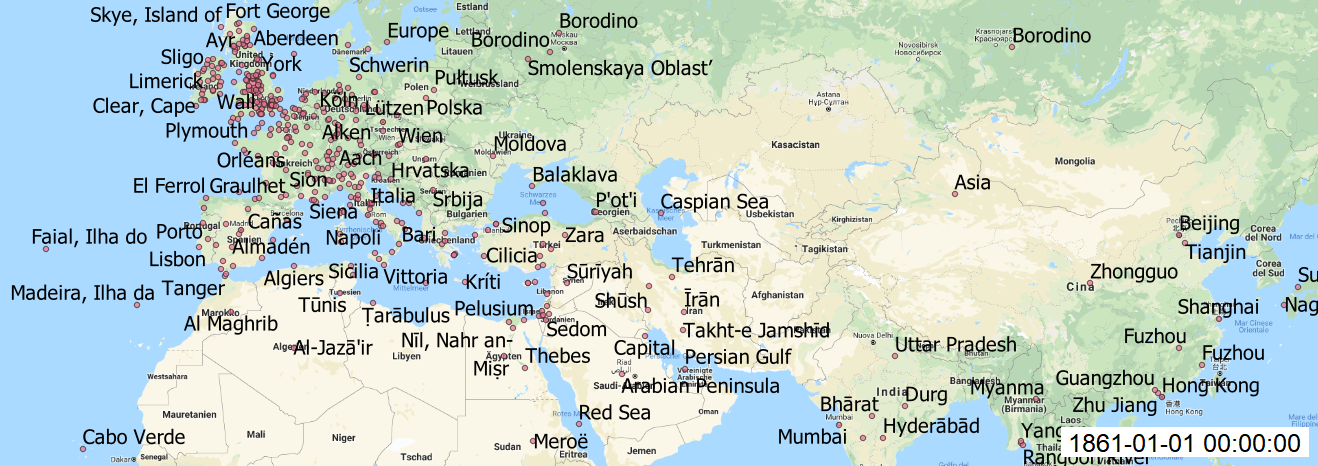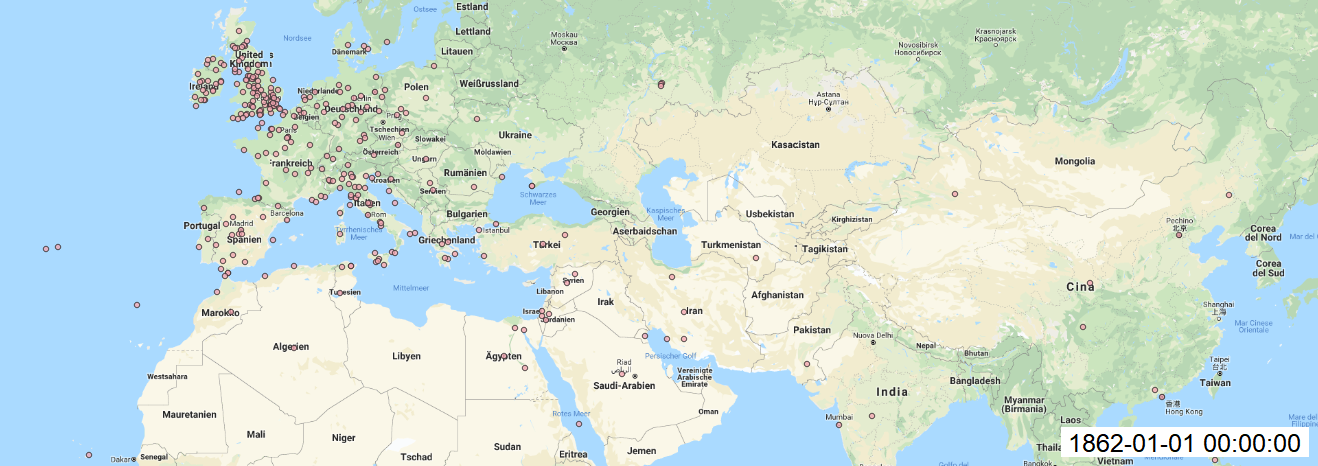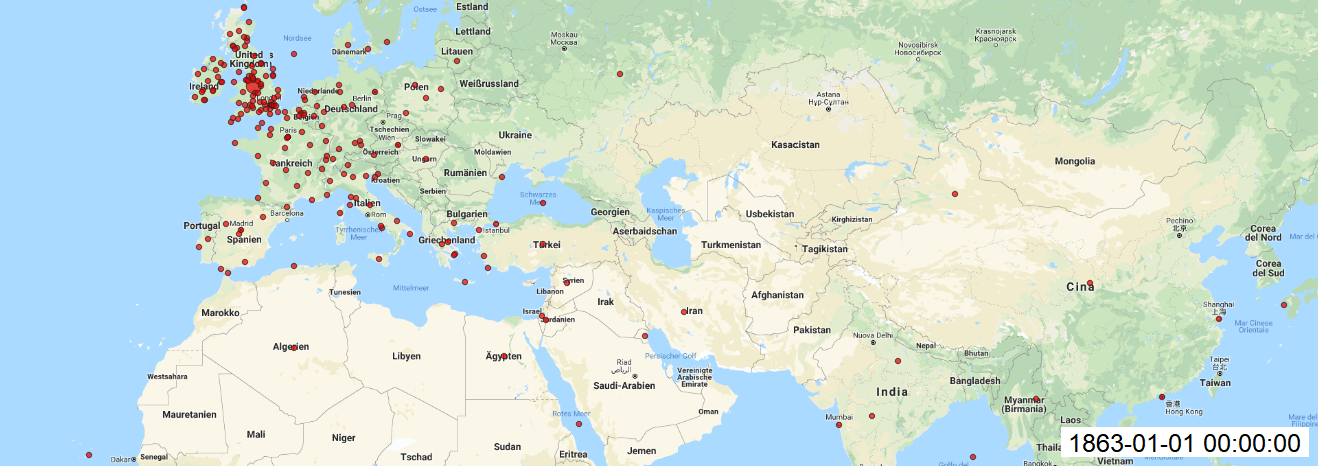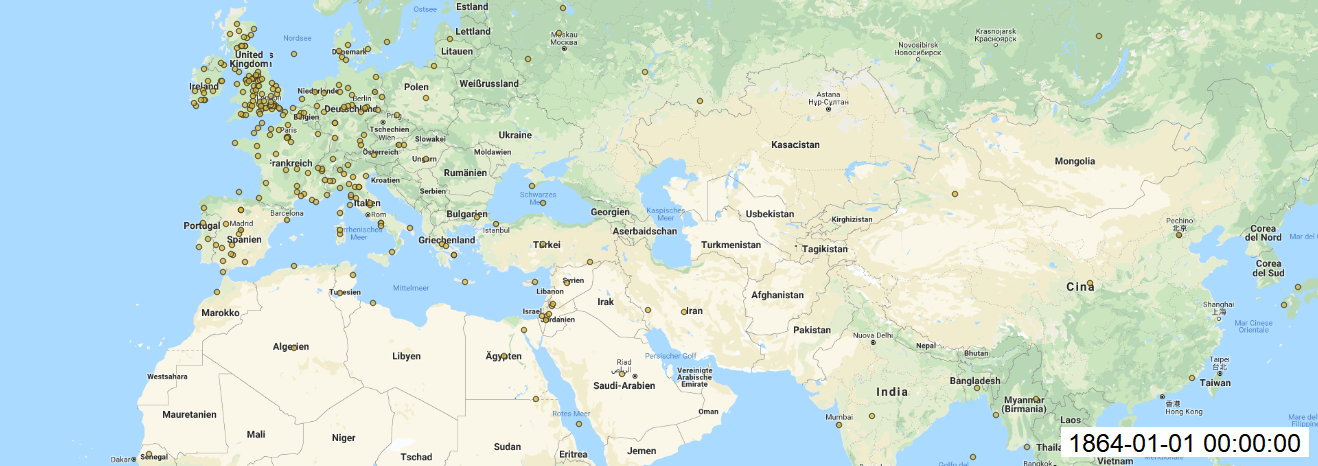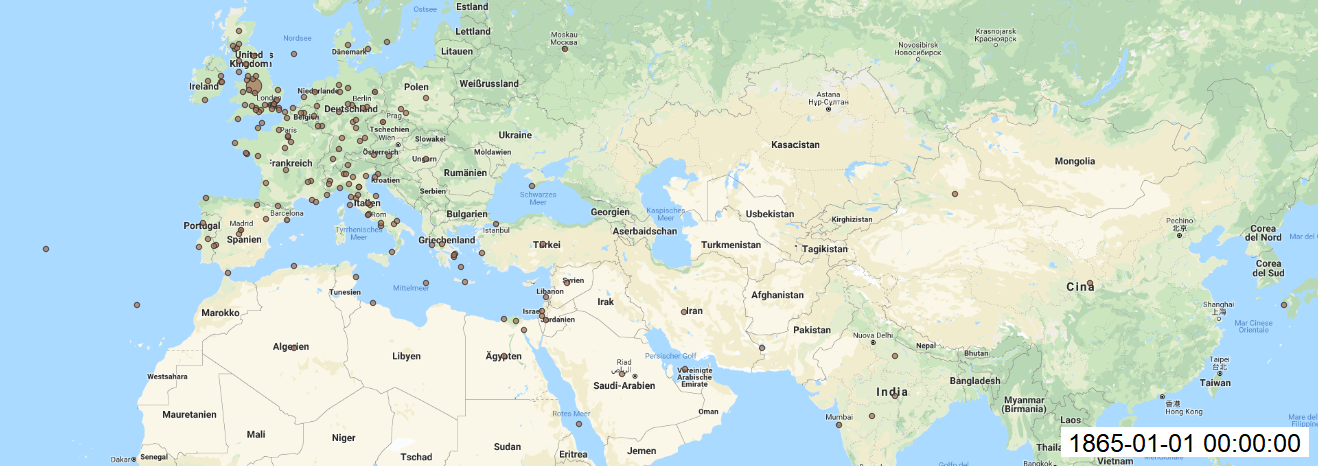I had some difficulties with previous post due the fact that I did not get precise coordinates for mapping, and I finally try this alternative code, which gave me better results and I made final maps for each year from dispatch file.
Please find below detail explanation with code.
Script 1:
import re, os
source = "C:/Users/Tatjana Smiljnic/Desktop/univie-tnt-2019.github.io/Lesson_10/tgn_xml_0619/" # xml files
oldPath = "C:/Users/Tatjana Smiljnic/Desktop/univie-tnt-2019.github.io/Lesson07/wget-activehistory/" # first dispatch
newPath = "C:/Users/Tatjana Smiljnic/Desktop/Lesson_10_new/" # new path to save files
lof = os.listdir(oldPath)
def generate(filter): #function where filter will be our input (the year)
topCountDictionary = {} #creating dictionary for tgn-number and frequency
counter = 0 #general counter to keep track of the progress
for f in lof: # looping through our all XML files
if f.startswith("dltext"): # fileName test
with open(oldPath + f, "r", encoding="utf8") as f1:
text = f1.read() # getting the content of the file
text = text.replace("&", "&") # cleaning the content of the file (that we do not need)
# find the date:
date = re.search(r'<date value="([\d-]+)"', text).group(1)
if date.startswith(filter): # making sure the output only includes data for the input year
for tg in re.findall(r"(tgn,\d+)", text): # finding the tgn info
tgn = tg.split(",")[1] # reducing the tgn informationen to the tgn number
# making a dictionary with tgn number as key and counting the frequency of its occurence:
if tgn in topCountDictionary:
topCountDictionary[tgn] += 1
else:
topCountDictionary[tgn] = 1
top_TSV = [] #creating a list to write a csv-file
# creating the list with our data:
for tgnnumber, frequency in topCountDictionary.items():
val = "%09d\t%s\t01-01-%s" % (frequency, tgnnumber, filter) # defining the precise syntax for the csv file
top_TSV.append(val) # putting the information into the list
# saving the data in csv format:
header = "freq\ttgn\ttimestamp\n"
with open("dispatch_toponyms_%s.tsv" % filter, "w", encoding="utf8") as f9:
f9.write(header+"\n".join(top_TSV)) # wirting the file into numerous lines incl. a header-line
# using our function for different years:
generate("1861")
generate("1862")
generate("1863")
generate("1864")
generate("1865")
def generateTGNdata(source): # function taking in the XML-files
lof = os.listdir(source) # creating a list out of the files
tgnList = []
tgnListNA = []
count = 0
print("Looping through list of XML files now")
for f in lof: # looping through the list of files
if f.startswith("TGN"): # fileName test
with open(source+f, "r", encoding="utf8") as f1: # opening and reading the files
data = f1.read()
data = re.split("</Subject>", data) # putting the content of the file into a list and splitting for every Subject
for d in data: # looping through the whole list of Subjects
d = re.sub("\n +", "", d)
if "Subject_ID" in d:
# SUBJECT ID
placeID = re.search(r"Subject_ID=\"(\d+)\"", d).group(1)
# NAME OF THE PLACE
placeName = re.search(r"<Term_Text>([^<]+)</Term_Text>", d).group(1)
# COORDINATES
if "<Coordinates>" in d:
latGr = re.search(r"<Latitude>(.*)</Latitude>", d).group(1)
declat = re.search(r"<Decimal>(.*)</Decimal>", latGr).group(1)
# extracting degrees and minutes
degrees = re.search(r"<Degrees>(.*)</Degrees>", latGr).group(1)
minutes = re.search(r"<Minutes>(.*)</Minutes>", latGr).group(1)
# calculating the decimal with dividing minutes by 60 which will give us a float decimal (R)
# try and catch in case any of the used variables is empty.
try:
minlat = float(minutes)/60
# than add the degree and the result of the calculation and make a string out of it str(float(D)+R)
lat = float(degrees)+minlat
lat = str(lat)
if "-" in declat: # as decimal is showing the direction with both positive and negative numbers
lat = "-"+lat # a minus has to be added in front of some values, to have unique value and precise data
except ValueError: # because some tags are empty
# print("Latitude can not be converted to a float", d). Everything that empty is should be recognized as NA and we do not use this data for our final mapping
lat = "NA"
# same for longitude:
lonGr = re.search(r"<Longitude>(.*)</Longitude>", d).group(1)
declon = re.search(r"<Decimal>(.*)</Decimal>", lonGr).group(1)
degrees = re.search(r"<Degrees>(.*)</Degrees>", lonGr).group(1)
minutes = re.search(r"<Minutes>(.*)</Minutes>", lonGr).group(1)
try:
minlon = float(minutes)/60
lon = float(degrees)+minlon
lon = str(lon)
if "-" in declon:
lon = "-"+lon
except ValueError:
# print("Longitude can not be converted to a float", d)
lon = "NA"
else:
lat = "NA"
lon = "NA"
tgnList.append("\t".join([placeID, placeName, lat, lon])) # finally, creating a list of all the places with coordinates
# print(tgnList)
if lat == "NA" or lon == "NA":# making a list of all the places without coordinates (should be printed, but we do not use for final mapping)
# print("\t"+ "; ".join([placeID, placeName, lat, lon]))
tgnListNA.append("\t".join([placeID, placeName, lat, lon]))
# saving the files:
header = "tgnID\tplacename\tlat\tlon\n" # headers delimited by a TAB
with open("tgn_data_light.tsv", "w", encoding="utf8") as f9a: # saving the list with coordinates
f9a.write(header+"\n".join(tgnList))
with open("tgn_data_light_NA.tsv", "w", encoding="utf8") as f9b: # saving the list of places without coordinates
f9b.write(header+"\n".join(tgnListNA))
print("TGN has %d items" % len(tgnList)) # print
print("%d items do not have coordinates" % len(tgnListNA)) # print
generateTGNdata(source)
Script 2:
import re, os, csv
# loading TGN data into a dictionary (with a function):
def loadTGN(tgnTSV): # defining the function
with open(tgnTSV, "r", encoding="utf8") as f1: # opening the previously created (and saved) tgnTSV-file
data = f1.read().split("\n") # creating a variable containing the data of the tgnTSV-file separated into lines
dic = {} #making the dict we will use
# looping through every line:
for d in data:
d = d.split("\t") # splitting the data with TABs
dic[d[0]] = d # filling the dict with the keys and values
return(dic)
# matching our data-files with the tgn-data:
def match(freqFile, dicToMatch): # defining the function and its intakes
# opening the previously made and saved freqFile:
with open(freqFile, "r", encoding="utf8") as f1:
data = f1.read().split("\n")
# creating all the lists we need:
dataNew = []
dataNewNA = []
count = 0 # general counter to keep track of the progress
for d in data[1:]: # looping through our toponymes-file
tgnID = d.split("\t")[1] # getting the tgn-number so we can compare it to the one in the dict, start counting the columns with 0
freq = d.split("\t")[0] # getting the frequency so we can write it into a csv
timestamp = d.split("\t")[2]
if tgnID in dicToMatch: # matching places to the dict by tgn-number
val = "\t".join(dicToMatch[tgnID]) # variable for the entry in the dict
val = val + "\t" + freq + "\t" + timestamp # putting the frequency and the timestamp to the entry in the dict
if "\tNA\t" in val: # creating lists with the toponymes without and with coordinates
dataNewNA.append(val)
else:
dataNew.append(val)
else:
print("%s (%d) not in TGN!" % (tgnID, int(freq))) # states which tgnID could not be found and what frequency it had
count += 1
# defining the names of the header:
header = "tgnID\tplacename\tlat\tlon\tfreq\ttime_stamp\n"
#creating a file with all the toponymes with their coordinates:
with open("coord_"+freqFile, "w", encoding="utf8") as f9a:
f9a.write(header + "\n".join(dataNew))
#creating a file with all the toponymes without coordinates:
with open("coord_NA_"+freqFile, "w", encoding="utf8") as f9b:
f9b.write(header + "\n".join(dataNewNA))
print("%d items have not been matched..." % count) # print all the items that could not been matched
dictionary = loadTGN("tgn_data_light.tsv") # variable for the Getty Gazetteer we previously cleaned up
# running and matching the two functions using our toponyms and the "tgn_data_light.tsv"
match("dispatch_toponyms_1861.tsv", dictionary)
match("dispatch_toponyms_1862.tsv", dictionary)
match("dispatch_toponyms_1863.tsv", dictionary)
match("dispatch_toponyms_1864.tsv", dictionary)
match("dispatch_toponyms_1865.tsv", dictionary)
Results:
With this results (picture below) we can see that coordinates are more precise to make final mapping in QGIS.
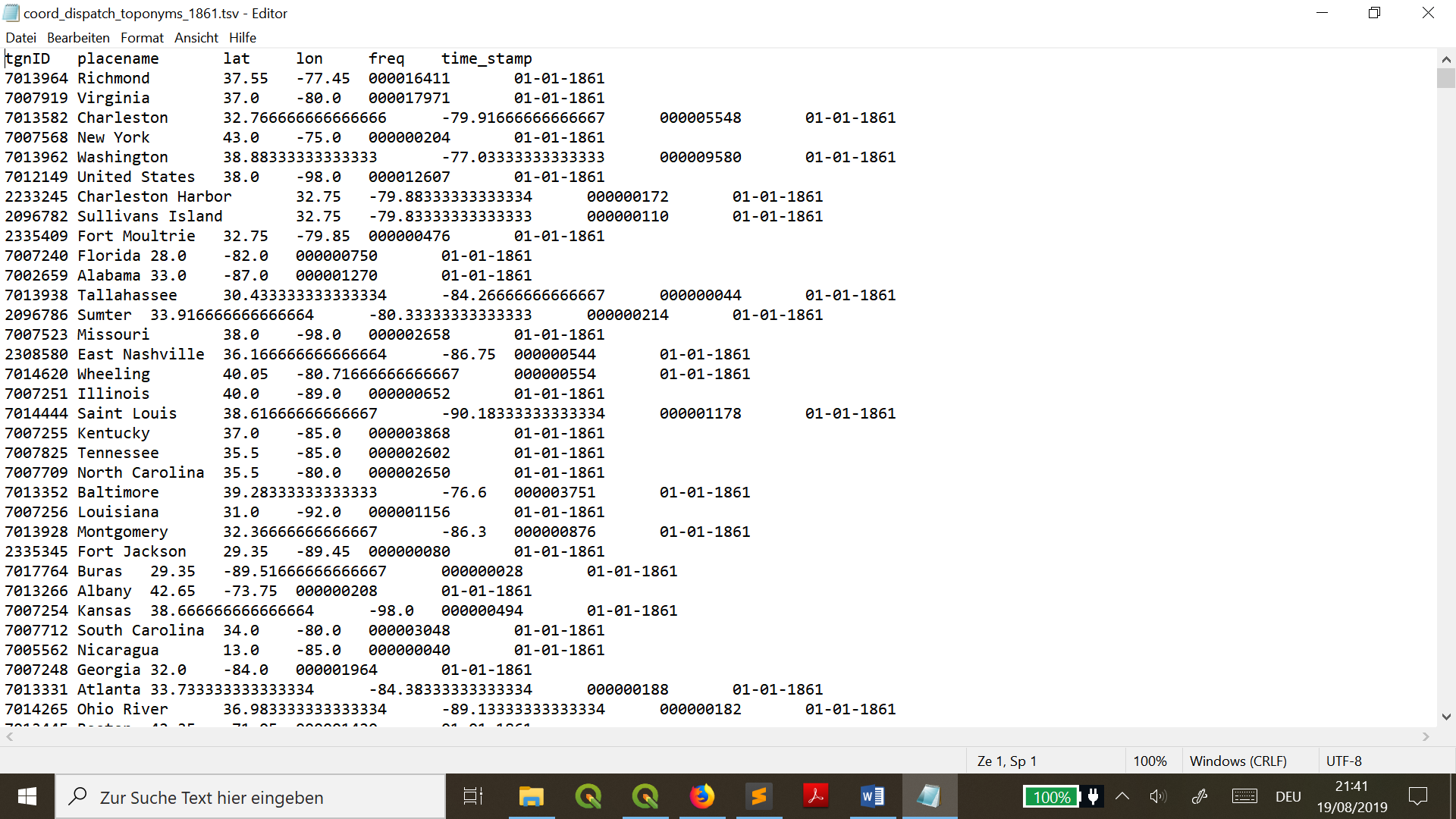
Maps:
In QGIS, I made add Layer as Delimited Text Layer and styled the layer with size of circles, transparency, labels for each year. Finally, I installed Time Manager plugin to animate my maps over time and saved each build. I created gif file to see changes over time.
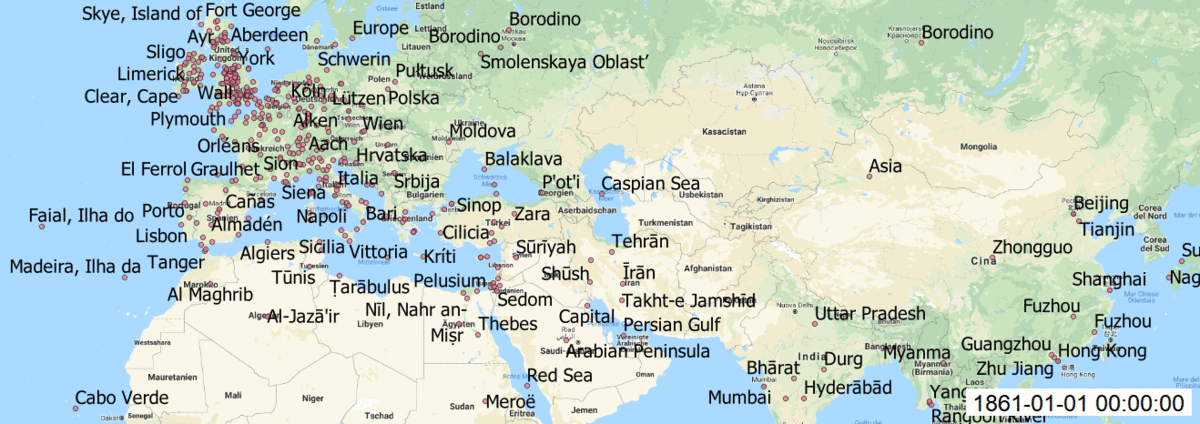
As well each map created with Time manager plugin.
